Email drip campaigns are perfect for luring, educating and rewarding your leads in those micro-moments of the buyer journey. Best of all they reel in an average open rate of around 46% and a 24% click-to-open rate.
So whether you’re looking at a welcome series, lead-nurture or an upsell campaign, we’ll be covering everything from what email drip marketing is and why you need it, to when you should employ a drip campaign and how to track success.
What is an email drip campaign?
An email drip campaign can be a stand-alone or series of automated emails to address specific times, events, or user behaviour. There are various micro-moments in a user’s journey: when they sign up, when they abandon an action, or when they make a purchase and so on.
Drip campaigns help you capture and leverage these moments to engage your prospects with relevant messages. This method helps you target users’ emotions in a targeted and personalised way without coming across as aggressive and sale-sy.
Why do you need it?
For starters, a well-constructed drip campaign can boost your click rates by 119% compared to one-off promotional messages. Apart from this, you need to have an email drip campaign in your marketing strategy because:
- It helps you keep in touch with your customers, keeping your brand top-of-mind. Moreover, since these emails are highly personalised and nuanced, they are much more effective than cold emails.
- Drip marketing is a vital way to gain and nurture qualified leads. Personalised and on-demand emails pave the way to meaningful interactions and accelerate conversions.
- It can be a potent way to cross-sell and upsell. Once you successfully engage users and bring them to your site, the chances of them reacting to your promotional messages increase.
Learn about how effective email campaigns can land you more leads: 5 Ways to Generate More Leads Through Email Marketing
When should you use an email drip campaign?
The buyer journey is definitely complex so there are many stages at which you could get creative and insert an email drip campaign. But to save you time, we’ve listed below email series that we believe are essential, personable and most importantly easy for you to execute.
Drip campaigns based on dates or events
- Anniversaries like birthdays or date of first purchase
- Subscription renewal
- Pre/post events
Drip campaigns based on user behaviour
- Acknowledging first purchase with a thank you email
- Welcome emails while onboarding
- Remind them about their abandoned carts
Let’s dive deeper into them.
Anniversary Emails
Email has a magic touch that social media can’t match. You’ve got the data to power a more personalised experience for your readers. Anniversary emails are a simple yet effective example of a personalised drip campaign. Not only do these feel like they’ve been curated for the individual but they are the perfect excuse to touch base in a non-sales-ly way. Anniversary emails are the perfect opportunity to entice subscribers with a special offering whether that’s free shipping, a freebie upon purchase or a discount.
Here are a few important subscriber anniversaries that you can acknowledge:
- Birthday anniversary email
- First purchase anniversary
- Subscription anniversary
- Year-in-review
Spotify uses a year-in-review email to focus the content on their customers. While this email is purely created for their subscribers’ benefit, you could take this opportunity to add an upsell at the end.
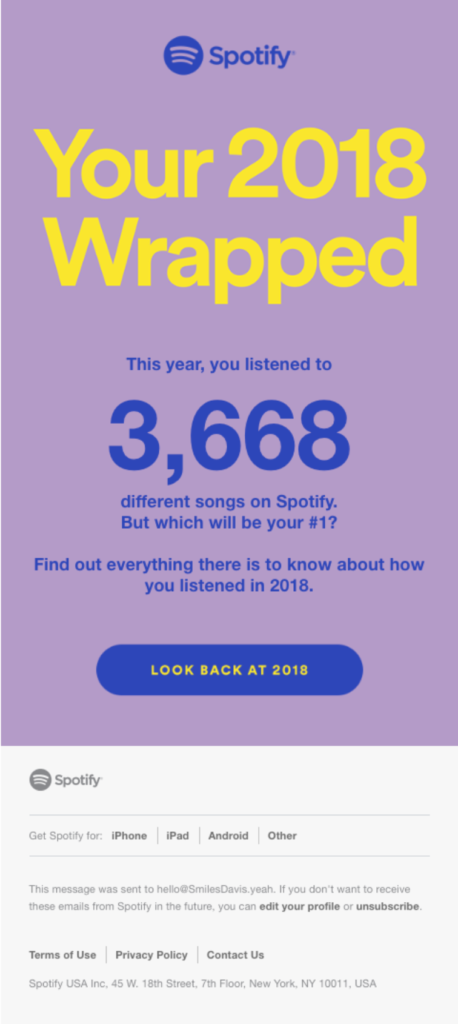
Reminder for subscription renewal
If your business is subscription-based, a fast-approaching expiry date is a perfect excuse to remind customers of your service value. Got any new products or releases? Or an exciting campaign in the works? Now would be the perfect time to promote anything that would be valuable to your subscribers and entice them to renew their subscriptions.
We recommend setting up a series of emails to gently remind customers about the end of their subscription whilst convincing them to stay. Take Miro’s drip feed email which shows subscribers how easy it is to integrate with other popular tools to increase team collaboration. This email would be suitable in a series of emails leading up to the end of the trial period or subscription renewal period.
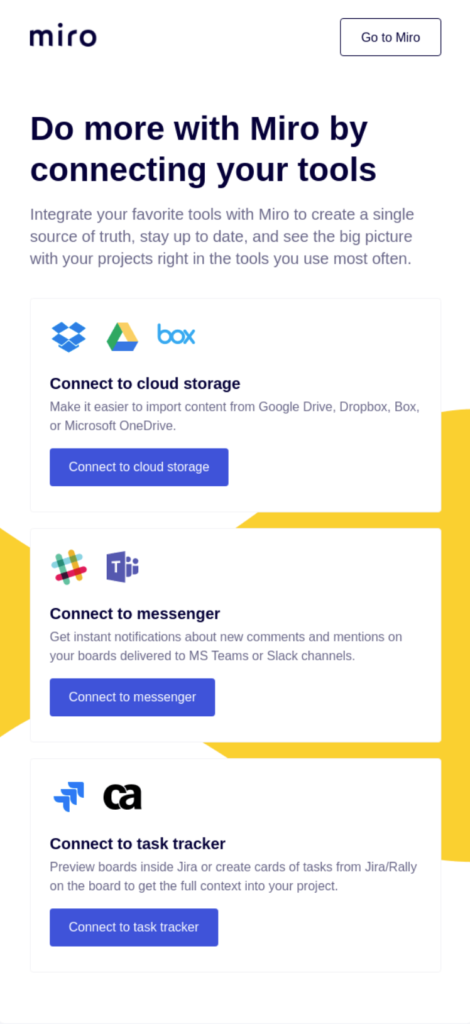
As most subscriptions usually roll over to the next month or calendar year, businesses will refrain from sending reminder emails to their database to avoid losing customers. We don’t recommend opting for this strategy. Seeing an unexpected charge in their bank account will not only leave a bad taste but will most likely prompt your subscriber to immediately terminate their subscription.
Event Email Drip Campaign
You’ve captured your leads now it’s time to nudge them down the funnel. It’s important to keep our event top-of-mind by sending out regular reminders to our database. You can create a drip campaign of three to four email series, which may include:
- Official email invite to an event
- Highlights of the event
- Notable speakers
- Reminder on the day before the event
It’s also just as important to keep your attendees engaged during the event, especially when it’s virtual. Try sending a combo of email and SMS reminders, however, make sure your text notifications are only sent when attendees are likely to step away from their screens. You don’t want to annoy your attendees with a constant phone buzzing throughout the event.
Here is the basic automation blueprint of how we drip-fed email reminders to attendees for our virtual EMSA Event:
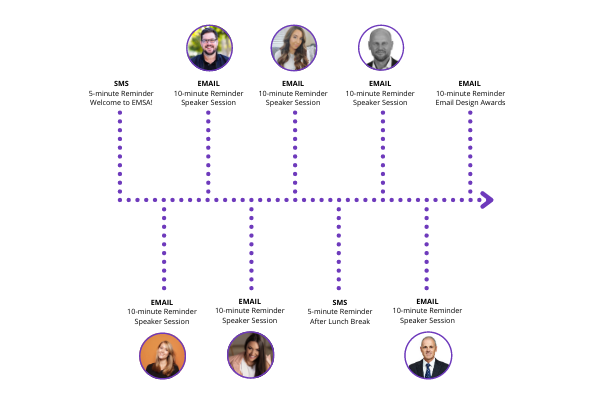
Follow the first purchase with a thank you
A user might have scrolled through a million websites and marketplaces and spent a great deal of time before arriving at your product page and ending their buying journey. Show your gratitude for choosing you and request a revisit. Also, show product recommendations that align with or complement their previous purchase.
We like this email by Allergy Buyer Club which provides customers a how-to guide that relates to their recent purchase. They also provide product recommendations and a referral discount to encourage repeat purchases.

Welcome emails while onboarding
Make sure you don’t overwhelm your subscribers as soon as they walk through the front door. Set up a series of emails over time so that you can drip-feed information at a comfortable pace. It’s up to how your business will serve information and what you deem important but in any onboarding drip campaign we recommend covering the following:
- Welcome them on board and give them a taste of what’s to come
- Set clear expectations and showcase the perks
- Let them know about your initiatives and brand as a whole
- Share helpful resources or tips to guide them through the onboarding journey
- Take them through your offering/catalogue
We like how Framer’s gives their customers a tutorial video as well as outlining the next steps below, giving them the option to take a guided tour or tackle the set-up themselves!
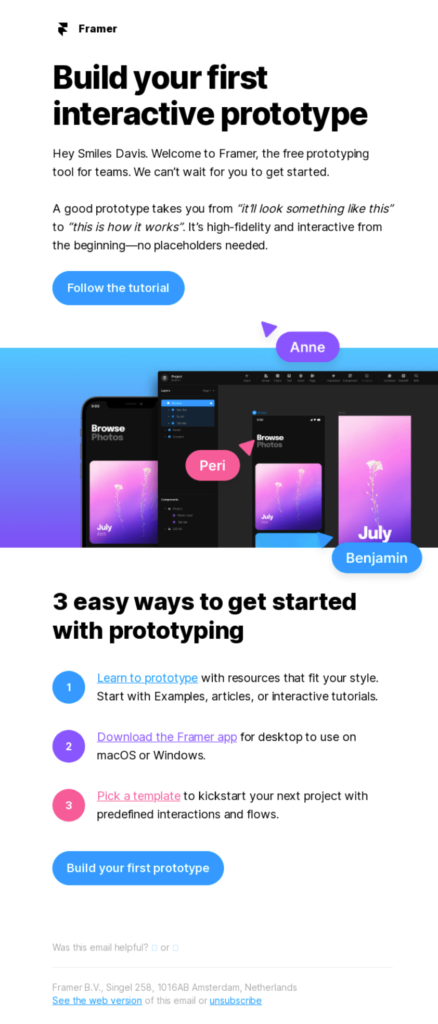
Remind users about their abandoned carts
There’s no surprise that online shoppers are becoming smarter. Instead of adding items to their cart and heading straight to payment, customers are abandoning their carts as a way to conduct consumer research.
We’re not saying you need to be offering a discount in order to stay competitive. But it would be a good idea to create a more personalised email drip campaign to lure them back. Brooklinen’s abandoned cart gives product recommendations based on the user’s cart items. This gives uses subscribers the ability to browse the catalogue via email.
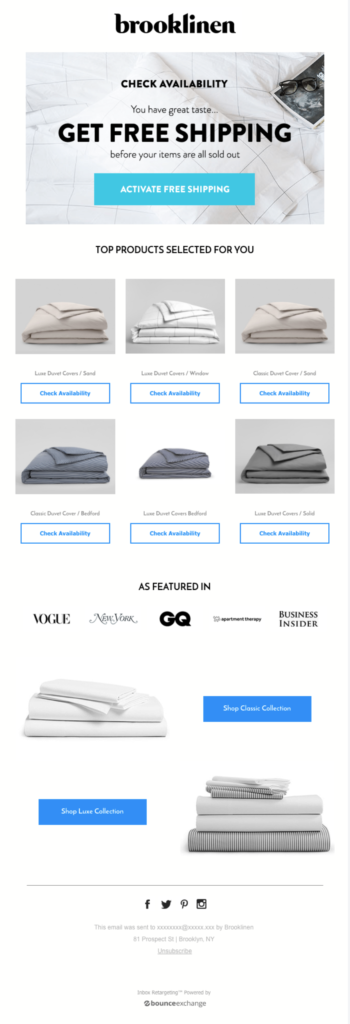
Some Top KPIs to Track
If you’re setting up a series of emails to send over time, make sure you continue to track the results for each individual send. After a couple of months, you’ll be able to accumulate your data to see which emails garner the best results.
Here are some KPIs that you can track the success of your email drip campaign:
Open rate:
An open rate higher than 20% means you are running a well-optimised drip campaign. If some emails are consistently recording below-average open rates we suggest tweaking your email subject line and preview text to make it more compelling.
Click rate:
Click rates will give you a better indication if subscribers are engaging with the content of your email. If your click-to-open rate (CTOR) is any lower than 15%, look at optimising email content or positioning your main CTA in a more prominent position. Our click maps in our reporting tab will also help you identify what email design elements work best at driving more click-throughs.
Conversion rate:
Your conversion rate will be tied to your CTA and its effectiveness. Make sure your subscribers have a clear understanding of what action you want them to perform. The ideal email conversion rate lies somewhere between 2-5%.
Learn more about how to create effective email CTAs from our blog: Irresistible Call to Action Buttons That Will Boost Your Email Conversions
Unsubscribe rate:
In your email drip series, it’s important to keep an eye on which emails are receiving the highest unsubscribe rates. An unsubscribe rate for a particular email shouldn’t be any higher than 0.5%. Any higher than this usually means the content you’re pushing out doesn’t particularly resonate with them or you may be sending out too many emails.
Bounce rate:
If you’re finding over time emails are continuing to bounce, it can be a good indication that you’re in desperate need of a database clean. You may want to consider setting up a double opt-in process for your newsletters to help weed out any spambots or non-existent email addresses.
Now that you know the mechanics behind email drip campaigns it’s time to set one up in your account. If you want to know more about email drip marketing and how to set it up in your Vision6 account, check out our Powersession: Educate your contacts with a series of emails over time.



